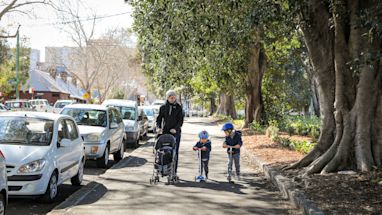We aim to reach our net zero goal 5 years earlier than planned.
This goal is a feature of our proposed new environmental strategy 2021-2025, which highlights our commitment to tackling the climate emergency.
The strategy was endorsed at our May council meeting. It is open for feedback now until Wednesday 16 June.
“Overwhelming climate research tells us we can’t afford to take our time reducing carbon emissions in Australia – emissions need to plummet now,” Lord Mayor Clover Moore said.
“The City of Sydney was the first local government in Australia to become carbon neutral in 2007 and our operations are now powered by 100% renewable electricity.
“This year we’ll meet our 2008 goal to reduce operational emissions by 70% by 2030 - 9 years earlier than initially targeted. We’re leading by example to tackle the climate crisis, and reaching net zero as soon as possible is the next step.”

New research from the Climate Council, released in April 2021, reiterated the need for the world to reach net zero emissions by 2035 to avoid the catastrophic consequences of more than 1.5 degrees of global heating.
“While the City of Sydney cannot tackle the climate crisis alone, we can lead and encourage others to do the same within their communities,” the Lord Mayor said.
Achieving net zero means the greenhouse gas emissions produced in an area must not exceed the greenhouse gas emissions taken out of the atmosphere through offset programs. The way to do this is to slash the amount of emissions generated in the local area.
Our new strategy includes targeted programs to manage waste, energy and fuel as we move to meet the challenges of the climate crisis and create a city that is net zero in less than 15 years.
Greening the grid
Energy consumption produces 73% of the local area’s greenhouse gas emissions.
We aim to significantly reduce this number by encouraging businesses, residents and other organisations to use renewable energy sources and opt for 100% GreenPower electricity plans.
Tackling transport emissions
Transport is the second biggest contributor to emissions after energy, and while we don’t control much of the sector, our partnerships with federal and state governments will make it easier for them to achieve their emissions targets and to support off-street charging stations for electric vehicles.
We’ll continue to encourage a move away from private vehicles and towards public transport, walking and cycling, as well as supporting businesses to shift to electric vehicles.

War on waste
From tackling single-use plastics to recycling food scraps, reducing waste and better waste management is another key component of our plans to lower the area’s emissions.
Food is by far the greatest contributor to residential waste, accounting for more than a third of space in our bins.
Our food scraps recycling trial is accessible by around 11,000 households, and another 10,000 households are expected to take part by September 2021.
Every tonne of food waste we divert and process saves 1.69 tonnes of carbon emissions, with waste and waste management making up around 9% of our emissions.

Next steps
Our new plans also address the development of energy efficient buildings and the regeneration of polluted waterways, air and land, as well as help us prepare for how the area can adapt to the climate crisis.
The new plan builds on the work we’ve done to date. Just some of our key achievements include reducing our own operational emissions by 76%, establishing a precinct recycled water scheme at Green Square, and making e-waste recycling collections available to all residents.
Have your say
We welcome your feedback on our new 5-year strategy. Get it in by 16 June.
Published 11 May 2021, updated 25 May 2021



